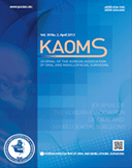Journal of the Korean Association of Oral and Maxillofacial Surgeons
- P-ISSN2234-7550
- E-ISSN2234-5930
- SCOPUS, KCI, ESCI
 ISSN : 2234-7550
ISSN : 2234-7550
Versatile midfacial degloving approach in oral and maxillofacial surgery
Umamaheswari G. (Tamilnadu Government Dental College and Hospital, Chennai)
Prachi Parab (Trinelveli Medical College and Hospital, Trinelveli)
Suresh Kumar (Trinelveli Medical College and Hospital, Trinelveli)
Devarathnamma M.V. (Navodaya Dental College, Raichur)
Abstract
Objectives: Oral and maxillofacial surgeons must gain mastery of various approaches to the midface due to the increasing incidence, complexity, and severity of presenting midfacial fractures. Unlike in the case of other body parts, the need to preserve facial aesthetics makes it more difficult for the surgeon to select an approach for managing the facial injuries. The midfacial degloving (MFD) approach is a combination of intraoral and intranasal incisions made to access the midface without any external incision. The aim of the present study was to evaluate the efficacy of MFD in maxillofacial surgery and to assess its advantages and complications. Materials and Methods: The MFD approach was used in five cases, with three cases treated with open reduction and internal fixation and two cases operated on for posttraumatic deformity. Nasal dorsum augmentation was completed in three cases and nasal osteotomy was performed in one case. The bicoronal flap technique was combined with MFD for frontal bone augmentation in one case. The intraoperative time required for flap completion and the ease of performing the planned procedures were noted. Postoperative evaluation was done for reduction, aesthetics, function, and complications. Results: Access was excellent for performing all planned procedures. Average time spent for flap elevation and exposure of the midface was 63 minutes. Complications like postoperative swelling, infraorbital nerve paresthesia, and intranasal crusting were all transient. No long-term complications like stenosis of the nose, sneer deformity, or weakness of the facial muscles were noticed. Additionally, no complications were noted when MFD was combined with bicoronal flap. Conclusion: Though the MFD approach is technically demanding and takes more time than other facial approaches, it should be learned and applied by maxillofacial surgeons in selective cases, as it provides complete exposure of the midface without facial scarring.
- keywords
- Surgical incision, Rhinoplasty, Aesthetics, Facial injury, Internal fracture fixation
- Downloaded
- Viewed
- 0KCI Citations
- 0WOS Citations